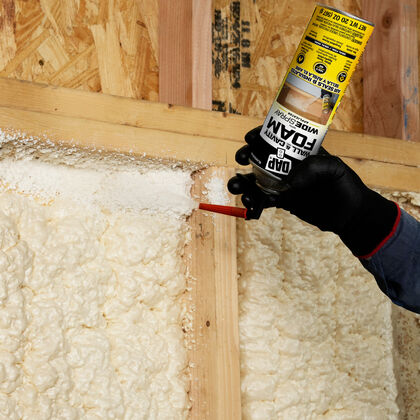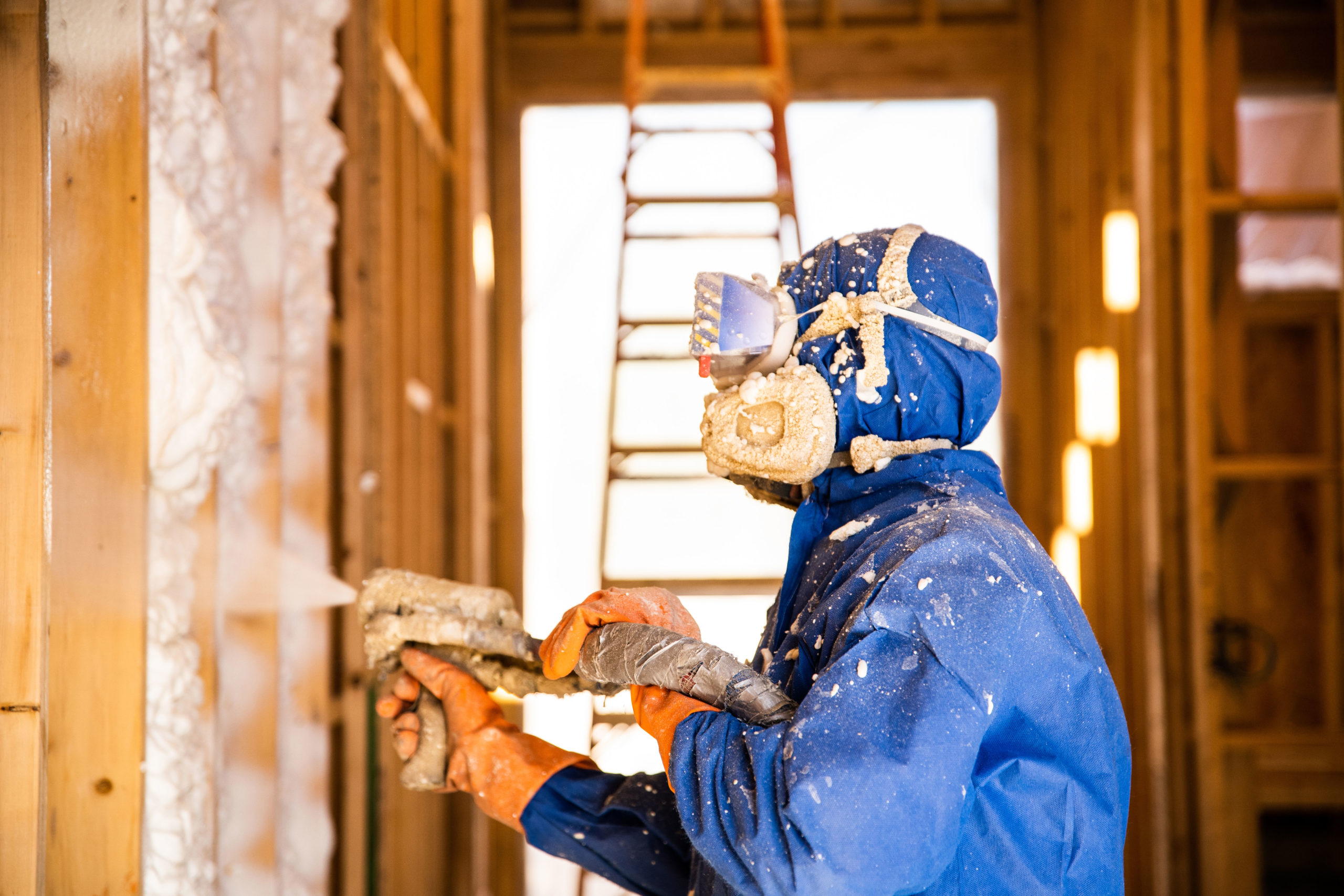Typical Myths Concerning Spray Foam: Debunking the Misconceptions
Typical Myths Concerning Spray Foam: Debunking the Misconceptions
Blog Article
Just How Spray Foam Can Enhance Power Efficiency in Any Type Of Building
Spray foam insulation has actually arised as a critical service for enhancing energy effectiveness throughout different building types. By creating an airtight seal that minimizes air leak, it effectively controls interior environments while significantly minimizing heating and cooling costs. Its excellent R-value and moisture-resistant residential or commercial properties add to long-term power savings and improved structure long life. As residential or commercial property proprietors significantly seek lasting services, the effects of spray foam insulation extend beyond simple utility cost savings. The full extent of its advantages, nevertheless, warrants a better examination of exactly how it can transform energy administration approaches in both household and industrial setups.
Comprehending Spray Foam Insulation
Spray foam insulation is progressively recognized for its premium thermal efficiency and flexibility in different applications. Made up primarily of polyurethane, this insulation material is used as a fluid that increases upon call, filling spaces and developing a seamless barrier. This unique residential property permits spray foam to adapt irregular surface areas, making it a perfect selection for both industrial and domestic frameworks.

Application of spray foam insulation is generally performed by skilled experts using specific tools, making certain optimum performance and safety - Spray Foam. The healing process is fast, permitting quick installation and marginal disturbance. Because of this, spray foam insulation is progressively being employed in new building and construction and retrofitting tasks because of its ability to boost architectural integrity while boosting general energy efficiency in structures
Benefits of Energy Effectiveness
Power effectiveness plays a critical role in lowering functional prices and minimizing ecological influence across various markets. By maximizing energy usage, house owners and businesses can attain significant financial savings on utility costs, which directly improves monetary efficiency. Efficient power intake means much less dependence on fossil fuels, consequently adding to a decrease in greenhouse gas discharges and promoting an extra sustainable atmosphere.
Moreover, energy-efficient buildings often experience increased residential property values. As power costs climb and sustainability ends up being a top priority for consumers, properties with enhanced power efficiency attributes are extra eye-catching on the market. This fad motivates financial investment in energy-saving modern technologies, which can better drive technology and economic growth.
Along with economic and ecological advantages, power effectiveness can also improve the general convenience and health of indoor rooms. Proper insulation and effective heating & cooling systems aid keep constant temperature levels, reducing drafts and moisture levels, which consequently can bring about better indoor air high quality.
Ultimately, the advantages of power performance expand past immediate cost savings, promoting a resistant economy, promoting environmental stewardship, and improving the quality of life for residents in any type of building.
Exactly How Spray Foam Functions
Typically used as a liquid, spray foam increases rapidly upon contact with surface areas, forming a strong barrier that successfully secures spaces and cracks. This distinct property results from its chemical make-up, primarily including polyols and isocyanates, which react when mixed to develop a foam that fills voids and sticks to various products, including concrete, metal, and wood.
Once used, the foam broadens to several times its original quantity, ensuring a tight seal that protects against air leak. This process significantly reduces thermal linking, which happens when warmth transfers with products, causing energy loss. The foam's high R-value, an action of thermal resistance, adds to enhanced insulation by minimizing warmth transfer in between the inside and outside atmospheres.
In addition, spray foam is immune to dampness and bugs, additionally enhancing its effectiveness in keeping power effectiveness. Its application can be customized to different areas, consisting of attic rooms, walls, and crawl rooms, maximizing insulation across a building. Spray Foam. In general, the ingenious layout and application approach of spray foam make it an effective option for boosting energy efficiency in any kind of structure, bring about reduced power costs and a more lasting built setting

Applications in Different Structures
Numerous applications of spray foam insulation can be located across numerous building kinds, enhancing power performance and comfort. In property homes, spray foam is frequently made use of in attics and walls to create a seamless barrier versus air leakages, significantly decreasing heating and cooling down demands. This application is particularly beneficial in older homes, where conventional insulation may be poor.
In industrial buildings, spray foam insulation is put on roof systems and outside wall surfaces, which helps to boost thermal performance and secure against moisture invasion. Its light-weight nature makes it an excellent selection for retrofitting existing structures without adding significant weight. Additionally, spray foam can be utilized in industrial setups to shield pipelines and storage space tanks, preserving temperature control for sensitive materials.
Institutional buildings, such as healthcare facilities and colleges, advantage from spray foam insulation by guaranteeing a regular interior climate that sustains resident convenience and health. The versatility of spray foam allows it to adjust to numerous building sizes and shapes, making it a favored option for engineers and contractors looking for reliable insulation options. On the whole, spray foam insulation works as an important component in achieving energy-efficient structures across all markets.
Long-Term Price Savings
Spray foam insulation offers substantial lasting price savings for structure proprietors and owners by lowering power intake and decreasing utility costs. By providing a premium air seal, spray foam reduces the seepage of outside air, therefore boosting the thermal performance of a structure. This results in much more effective home heating and cooling procedures, which can result in considerable decreases in power prices gradually.
Along with immediate cost savings on energy costs, the longevity and longevity of spray foam insulation add to its economic benefits. Unlike standard insulation materials, which may droop, resolve, discover this or weaken, spray foam why not try these out maintains its efficiency for decades, decreasing the requirement for frequent replacements or repair services. This longevity translates to reduce upkeep prices and much less interruption for residents.
Moreover, buildings furnished with spray foam insulation usually appreciate an increase in building value, making them much more attractive to potential purchasers or tenants. As power performance becomes significantly prioritized, buildings with reliable insulation options attract attention in the marketplace. Ultimately, the assimilation of spray foam insulation not just improves comfort yet additionally represents a tactical financial investment that generates significant economic benefits over the long-term.
Final Thought
In verdict, spray foam insulation acts as a crucial component in improving power efficiency across diverse building kinds. Its capacity to produce a smooth obstacle against air leakage, incorporated with moisture-resistant properties and high r-values, significantly decreases energy usage and connected prices. The execution of spray foam not just contributes to regular interior temperature levels however additionally enhances residential or commercial property worth, underscoring its function as a sensible financial investment for both domestic and business residential or commercial properties.
Spray foam insulation has actually arised as an essential option for enhancing power effectiveness across different building types. Spray Foam. As a result, spray foam insulation is increasingly being employed in new building and construction and retrofitting tasks due to its capability to boost architectural stability while improving overall power efficiency in buildings
In general, the ingenious design and application technique of spray foam make it great post to read an effective solution for improving power effectiveness in any type of structure, leading to lowered energy expenses and an extra sustainable built atmosphere.
Countless applications of spray foam insulation can be discovered throughout different structure types, improving energy performance and convenience.In verdict, spray foam insulation serves as an important element in enhancing energy effectiveness throughout varied structure types.
Report this page